DeLonghi DDSX220 Bedienungsanleitung
DeLonghi
Luftentfeuchter
DDSX220
Lies die bedienungsanleitung für DeLonghi DDSX220 (3 Seiten) kostenlos online; sie gehört zur Kategorie Luftentfeuchter. Dieses Handbuch wurde von 2 Personen als hilfreich bewertet und erhielt im Schnitt 4.5 Sterne aus 1.5 Bewertungen. Hast du eine Frage zu DeLonghi DDSX220 oder möchtest du andere Nutzer dieses Produkts befragen? Stelle eine Frage
Seite 1/3

9
Read the safety warnings carefully before using the appliance.
1. DESCRIPTION
1.1 Description of appliance (A)
A1. Air outlet grill
A2. Lifting handles
A3. Room sensor air intake
A4. Castors
A5. Water level viewing window
A6. Condensate collection tank
A7. Condensate drain hose
A8. Silver ion dust lter
A9. Filter housing cover
A10. Continuous drain rubber stopper
A11. Continuous drain cap
1.2 Description of control panel (B)
B1. ON/STAND-BY button
B2. Ventilation button
B3. Dehumidifying button
B4. Dry button
B5. Timer button
1.3 Description of display (C)
C1. Full tank alarm
C2. Ventilation mode active
C3. % Relative Humidity
C4. Dry mode active
C5. Hours
C6. Dehumidifying mode active
C7. Low temperature alarm
C8. Timer function active
2. DRAINING THE CONDENSATE WATER
The condensate can be drained in 2 ways:
2.1 Draining into the tank
The condensate is drained directly into the tank (A6).
When the tank is full, the appliance stops and the control panel
(C) displays the tank alarm (C1).
To restore operation of the appliance, proceed as follows:
1. Remove the tank (g. 1) and empty it into a sink or bathtub.
2. Replace the tank in its housing, making sure the handle is
properly positioned (g. 2).
2.2 Continuous external draining
If the appliance is used for long periods of time without the
possibility to regularly empty the tank, the continuous drain
function should be used. Proceed as follows:
1. Remove the continuous drain cap (A11) from the spout,
turning it in an anti-clockwise direction, then remove the
rubber stopper (A10) from the opening (g. 3). (Watch out
for any leaking water!)
2. Attach the condensate drain hose (A7) to the spout (g. 4).
3. Make sure the hose is positioned below the spout (g. 5),
or the water will ow back into the tank of the appliance.
Also make sure there are no kinks in the hose.
3. MODE SELECTION
Connect the appliance to the mains supply. Upon rst use, the
symbol will appear on the display and at the same time,
an acoustic signal will sound to indicate that the appliance is in
stand-by mode.
1. To turn the appliance on, touch the button (B1).
The appliance will operate in the previously set mode.
2. If there is a blackout, when the power is restored the
appliance will resume operation in the previously set
operating mode.
Please note:
• If the symbol (C1) appears on the display, the
tank (A6) needs to be emptied or properly positioned. (see
paragraph “2.1 Draining into the tank”).
3.1 Dehumidifying mode
1. Touch the button (B3). The symbol (C6) will
blink on the display (g. 6).
2. The display shows the previously set relative humidity value.
When the symbol blinks, the setting can be changed
by repeatedly touching the button . There are 5
dierent relative humidity settings ranging from 30% (dry
environment) to 70% (humid environment). Depending
on the ambient conditions, it may not be possible for the
appliance to reach the minimum settable value. In these
cases it is recommended to heat the environment needing
to be dehumidied.
3. When the symbol stops blinking, the display shows the
percentage of relative humidity in the room. The appliance
may take a few seconds to display the value of the relative
humidity in the room.
4. When the room reaches the preset relative humidity level,
the appliance stops dehumidifying and operates at a very
slow ventilation speed.
3.2 Dry mode
1. Touch the button (B4). The display shows the
symbol (C4) (g. 7).
Note:
The appliance automatically operates at the maximum
dehumidifying capacity. Recommended for particularly humid
environments or to dry laundry more quickly.

10
3.3 Ventilation mode
1. Press the button (B2) . The display shows the
symbol (C2) and the selected speed (g. 8).
2. When the symbol blinks, the ventilation speed can be
adjusted by repeatedly pressing the button. The
display shows the number corresponding to the selected
speed:
(1 MIN; 2 MED; 3 ⇒ ⇒ ⇒ MAX).
3.4 Timer function
• The timer can be used to delay appliance start-up and
shut-down. This will avoid energy wastage, ensuring the
appliance operates only when needed.
• When programming is enabled, the display shows the
symbol (C8).
How to programme delayed start-up
1. With the appliance in stand-by mode ( ), press the
button (B5): the display will show the symbol
and the number relative to the selected hours (g. 9);
2. Set the desired number of hours by repeatedly touching the
button. 1, 2, 4, 6, 8, 12 hours can be selected.
3. After a few seconds, the appliance will return to stand-by
mode and the symbol will remain lit on the display.
4. After the programmed time, the appliance will turn on in
the previously set operating mode.
How to programme delayed shut-down
1. With the appliance running, press the button
(B5): The display shows the symbol and the relative
number of selected hours. (g. 9);
2. Set the desired number of hours by repeatedly touching the
button. 1, 2, 4, 6, 8, 12 hours can be selected.
3. After a few seconds, the display returns to the current
operating mode and the symbol remains lit.
4. After the programmed time, the appliance will
automatically turn o.
Note:
• Once the timer has been programmed, to see the remaining
time until start-up or shut-down, touch the
button once.
• To disable the timer function, press the button
twice, the symbol on the display will turn o.
4. CLEANING AND MAINTENANCE
• Always disconnect the appliance from the mains before
carrying out cleaning operations (g. 10).
• Never submerge the appliance in water.
4.1 Cleaning the cabinet
• Never pour water directly over the appliance (g. 11).
• Never use petrol, alcohol or solvents.
• Never spray insecticides or similar substances as these may
deform the plastic.
• Clean the surfaces of the appliance using a soft cloth and do
not use abrasive sponges as these may scratch the surfac
es
themselves. (g. 12).
4.2 Cleaning the dust or silver ion lter
The frequency of cleaning will depend on the frequency of use:
if used daily, it is recommended to clean the lter every week.
• Remove the lter housing cover (A9) (g. 13).
• Extract the dust lter (A8)(g. 14).
• Remove any dust from the lter using a vacuum cleaner.
(g. 15).
• If the dust lter is very dirty, rinse it well with warm water.
The water temperature must not exceed 40° C.
• Leave it to dry completely and replace it in its housing.
4.3 For long periods of downtime
• Disconnect the appliance from the mains and empty the
tank (A6).
• Clean the dust lter (A8) and replace it in its housing.
• Cover the appliance with a plastic bag to protect it.
5. TECHNICAL SPECIFICATIONS
Power supply voltage See rating plate
Rated input power “
Maximum input power “
Defrost device Yes
Hygrometer Yes
Ventilation speed 3
Filter Yes
Operating limits:
temperature
2°C - 3
0°C
relative humidity 30 - 90%
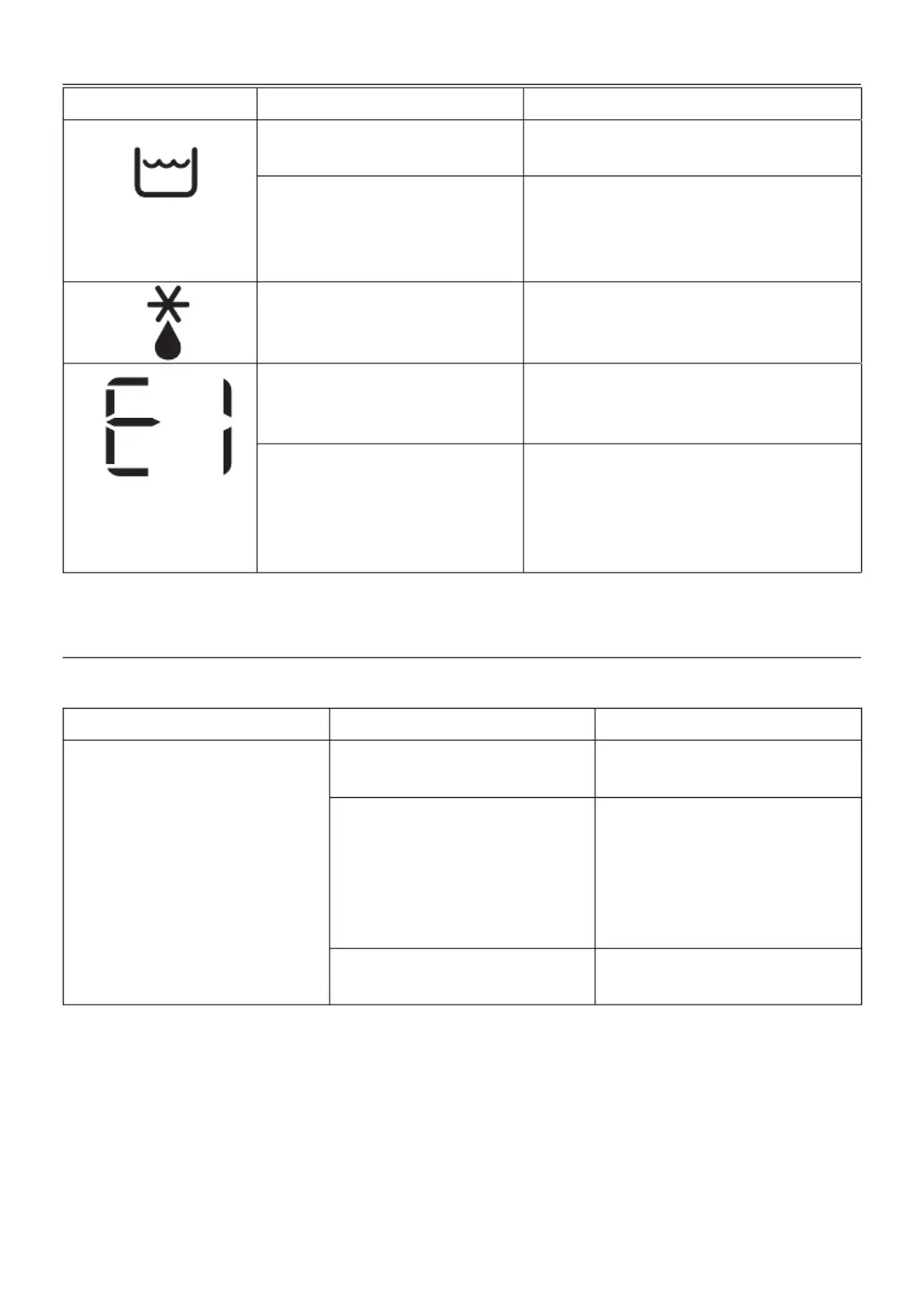
11
6. ALARMS SHOWN ON DISPLAY
ALARM CAUSE SOLUTION
Tank (A6) missing or incorrectly
positioned
Place the tank back in its correct position (see para-
graph “2.1 Draining into the tank”)
Tank full Empty the tank (see paragraph “2.1 Draining into the
tank””)
Room temperature too low (see op-
erating limits in chap. “5. Technical
Specications”)
Increase the ambient temperature if possible
Humidity in room too low or too high for
correct measuring (see operating limits
in chap. “5. Technical Specications”)
Move the appliance to another room with humidity
and temperature levels within the operating limits: if
the problem persists, call the Service Centre.
Faulty probe Contact the Service Centre
7. TROUBLESHOOTING
Below is a list of possible malfunctions.
If the problem cannot be resolved using the proposed solution, contact the Service Centre.
PROBLEM CAUSE SOLUTION
The appliance is operating in dehumid-
ifying mode, but the humidity does not
decrease
The lter is clogged Clean the dust lter (para. “4.2 Cleaning
the dust lter”)
Either the temperature or humidity in the
room is too low
In certain conditions the appliance will
not dehumidify: check the operating lim-
its of the appliance (see chapter “5. Tech-
nical Specications”). In certain cases, it
is recommended to heat the room need-
ing to be dehumidied.
The set relative humidity level is too high Set a lower humidity value (see para.
“3.1 Dehumidifying mode”).
Produktspezifikationen
| Marke: | DeLonghi |
| Kategorie: | Luftentfeuchter |
| Modell: | DDSX220 |
| Breite: | 383 mm |
| Tiefe: | 255 mm |
| Produktfarbe: | Weiß |
| Höhe: | 600 mm |
| Platzierung: | Flur |
| Display: | LED |
| Fassungsvermögen Wassertank: | 5 l |
| Geräuschpegel: | 44 dB |
| Geeignet bis zu Zimmergrößen von: | 90 m³ |
| Entfeuchtungskapazität (max.): | 20 l/24h |
Brauchst du Hilfe?
Wenn Sie Hilfe mit DeLonghi DDSX220 benötigen, stellen Sie unten eine Frage und andere Benutzer werden Ihnen antworten
Bedienungsanleitung Luftentfeuchter DeLonghi
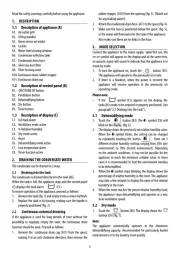
18 August 2025

15 Juli 2025

3 September 2024

DeLonghi Tasciugo AriaDry Multi DEX212SF Bedienungsanleitung
31 August 2024
26 August 2024

1 Juni 2024

22 Mai 2024
Bedienungsanleitung Luftentfeuchter
- Fresh
- Swan
- Fral
- Stylies
- Comfee
- Perfect Aire
- Kunft
- Ardes
- Nedis
- House & Luft
- Calorex
- Wilfa
- Soler & Palau
- Cotech
- Imarflex
Neueste Bedienungsanleitung für -Kategorien-
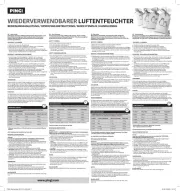
17 August 2025
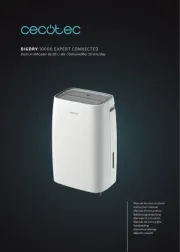
17 August 2025
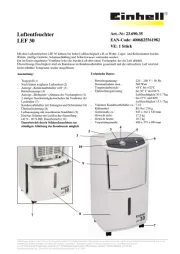
17 August 2025
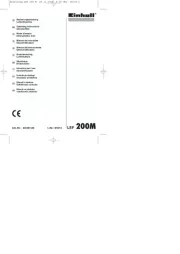
16 August 2025

16 August 2025

16 August 2025

15 August 2025
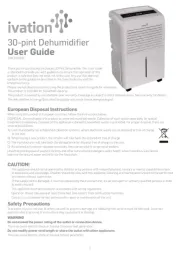
14 August 2025

14 August 2025
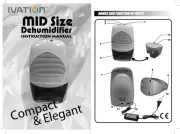
14 August 2025


